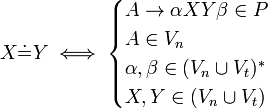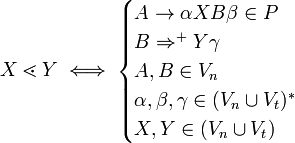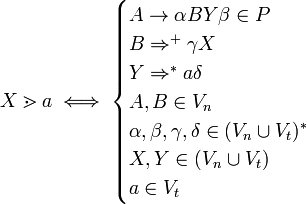Wirth–Weber precedence relationship
The Wirth–Weber relationship between a pair of symbols  is necessary to determine if a formal grammar is a simple precedence grammar, and in such case the simple precedence parser can be used.
is necessary to determine if a formal grammar is a simple precedence grammar, and in such case the simple precedence parser can be used.
The goal is to identify the when the viable prefixes have the pivot and must be reduced. A  means that the pivot is found, a
means that the pivot is found, a  means that a potential pivot is starting, and a
means that a potential pivot is starting, and a  means that we are still in the same pivot.
means that we are still in the same pivot.
Formal definition

Precedence relations computing algorithm
We will define three sets for a symbol:
Note that Head*(X) is X if X is a terminal, and if X is a non-terminal, Head*(X) is the set with only the terminals belonging to Head+(X). This set is equivalent to First-set or Fi(X) described in LL parser
Note that Head+(X) and Tail+(X) are  if X is a terminal.
if X is a terminal.
The pseudocode for computing relations is:
- RelationTable :=

- For each production

- For each two adjacent symbols X Y in α
- add(RelationTable,
 )
) - add(RelationTable,
 )
) - add(RelationTable,
 )
)
- add(RelationTable,
- For each two adjacent symbols X Y in α
- add(RelationTable,
 ) where S is the initial non terminal of the grammar, and $ is a limit marker
) where S is the initial non terminal of the grammar, and $ is a limit marker - add(RelationTable,
 ) where S is the initial non terminal of the grammar, and $ is a limit marker
) where S is the initial non terminal of the grammar, and $ is a limit marker
Note that  and
and  are used with sets instead of elements as they were defined, in this case you must add all the cartesian product between the sets/elements
are used with sets instead of elements as they were defined, in this case you must add all the cartesian product between the sets/elements
Examples

- Head+(a) =

- Head+(S) = { a, c}
- Head+(b) =

- Head+(c) =

- Tail+(a) =

- Tail+(S) = { b, c}
- Tail+(b) =

- Tail+(c) =

- Head*(a) = a
- Head*(S) = { a, c}
- Head*(b) = b
- Head*(c) = c
-

- a Next to S
- a
 S
S - a
 Head+(S)
Head+(S)
- a
 a
a - a
 c
c
- a
- a
- S Next to S
- S
 S
S - S
 Head+(S)
Head+(S)
- S
 a
a - S
 c
c
- S
- Tail+(S)
 Head*(S)
Head*(S)
- b
 a
a - b
 c
c - c
 a
a - c
 c
c
- b
- S
- S Next to b
- S
 b
b - Tail+(S)
 Head*(b)
Head*(b)
- b
 b
b - c
 b
b
- b
- S
- a Next to S
-

- there is only one symbol, so no relation is added.
precedence table:
| S | a | b | c | $ | |
| S |  |  |  |  | |
| a |  |  |  | ||
| b |  |  |  |  | |
| c |  |  |  |  | |
| $ |  |  |





